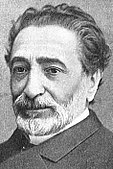Spanish general election, 1879
|
|
|||||||||||||||||||||||||||||||||
|---|---|---|---|---|---|---|---|---|---|---|---|---|---|---|---|---|---|---|---|---|---|---|---|---|---|---|---|---|---|---|---|---|---|
|
|||||||||||||||||||||||||||||||||
|
All 392 seats in the Congress of Deputies and 180 (of 360) seats in the Senate 197 seats needed for a majority in the Congress of Deputies |
|||||||||||||||||||||||||||||||||
| Registered | 846,961 |
||||||||||||||||||||||||||||||||
| Turnout | 652,000 (77.0%) |
||||||||||||||||||||||||||||||||
|
|||||||||||||||||||||||||||||||||
|
|||||||||||||||||||||||||||||||||
Arsenio Martínez Campos
Conservative
Arsenio Martínez Campos
Conservative
The 1879 Spanish general election was held on Sunday, 20 April and on Saturday, 3 May 1879, to elect the 1st Restoration Cortes of the Kingdom of Spain. All 392 seats in the Congress of Deputies were up for election, as well as 180 of 360 seats in the Senate.
This was the first election held under the Spanish Constitution of 1876 and the new electoral law of 1878, which re-established censitary suffrage.
The Spanish Constitution of 1876 enshrined Spain as a constitutional monarchy, awarding the King power to name senators and to revoke laws, as well as the title of commander-in-chief of the army. The King would also play a key role in the system of the turno pacífico (English: Peaceful Turn) by appointing and toppling governments and allowing the opposition to take power. Under this system, the Conservative and Liberal parties alternated in power by means of election rigging, which they achieved through the encasillado, using the links between the Ministry of the Interior, the provincial civil governors, and the local bosses (caciques) to ensure victory and exclude minor parties from the power sharing.
...
Wikipedia



